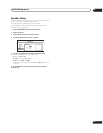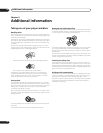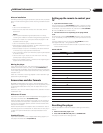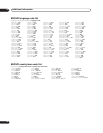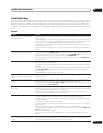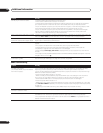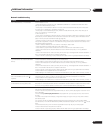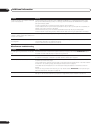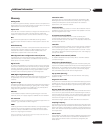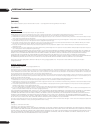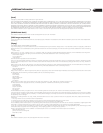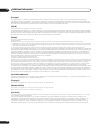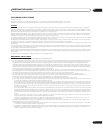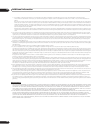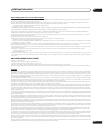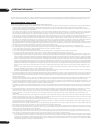
Additional information 09
53
En
Glossary
Analog audio
An electrical signal that directly represents sound. Compare this to
digital audio which can also be an electrical signal, but is an indirect
representation of sound. See also Digital audio.
Aspect ratio
The width of a TV screen relative to its height. Conventional TVs are
4:3 (in other words, the screen is almost square); widescreen
models are 16:9 (the screen is almost twice as wide as it is high).
BD-J
BD-J is the Java specification for BD-ROM, allowing content
providers to put interactive material linked to specific titles on the
disc.
Default Gateway
Default Gateway is a node on a computer network that serves as an
access point to another network. A default gateway (such as a
computer and router) is used to forward all traffic that is not
addressed to a station within the local subnet.
DHCP (Dynamic Host Configuration Protocol) Server
A DHCP server is a server that allocates IP addresses to hosts
(network devices). In most cases, a broadband router serves as a
DHCP server in a home network.
Digital audio
An indirect representation of sound by numbers. During recording,
the sound is measured at discrete intervals by an analog-to-digital
converter, generating a stream of numbers. On playback, a digital-
to-analog converter generates an analog signal based on these
numbers. See also Sampling frequency and Analog audio.
DRM (Digital Rights Management)
DRM is one of several technologies that controls access to and use
of digital data, such as music, movies and other copyrighted
contents.
Dynamic range
The difference between the quietest and loudest sounds possible in
an audio signal (without distorting or getting lost in noise). Dolby
Digital and DTS soundtracks are capable of a very wide dynamic
range, delivering dramatic cinema-like effects.
Ethernet
A frame-based computer networking technology for local area
networks (LANs). This player supports 100BASE-TX and 10BASE-T.
File extension
A tag added to the end of a filename to indicate the type of file. For
example, “.jpg” indicates an JPEG image file.
HDMI
HDMI (High-Definition Multimedia Interface) is a high-speed digital
interface which has the capability to support standard or high-
definition video plus standard to multi-channel surround-sound
audio on a single digital connection.
HDMI, the HDMI logo and High-Definition Multimedia Interface are trademarks or
registered trademarks of HDMI Licensing LLC.
Interactive audio
Interactive audio is Linear PCM (LPCM) audio activated by a BD-
ROM application and mixed with the primary audio. It is typically
used to provide dynamic sounds associated with interactive
applications, such as button sounds.
Interlaced video
A method of displaying a picture in which odd-numbered lines are
updated in one pass, then even-numbered lines updated in the next.
See also Progressive scan video.
IP (Internet Protocol) address
A unique number that devices use in order to identify and
communicate with each other on a network utilizing the Internet
Protocol standard, such as ‘192.168.0.1’. No duplicate numbers are
allowed in the network.
LAN cable
A cable that has an 8-pin modular plug on each end and is different
from a telephone plug which has 4 pins. A straight cable is used
when connecting this player to a home network via a hub. A cross-
over cable is used when connecting directly to a PC. Use category 5
(CAT-5) LAN cables.
MAC (Media Access Control) address
An address attached to the port of any device. The MAC address
cannot be changed.
PCM (Pulse Code Modulation)
A common system of encoding digital audio. Excellent quality, but
requires a lot of data compared to formats such as Dolby Digital and
MPEG audio. For compatibility with digital audio recorders and AV
amplifiers with digital inputs, this unit can convert Dolby Digital,
DTS and MPEG audio to PCM. See also Digital audio.
Pop-up menu (BD only)
A context-sensitive menu that can be used without interrupting
playback of a BD.
Progressive scan video
Also called non-interlaced video, this method of displaying a picture
updates all the lines in one pass, resulting in a more stable, flicker-
free image than interlaced video (for a given scanning rate). See also
Interlaced video.
Regions (DVD-Video and BD-ROM)
These associate discs and players with particular areas of the world.
This unit will only play discs that have a compatible region code (i.e.,
the same code as your player). You can find the region code of your
unit by looking on the rear panel. Some discs are compatible with
more than one region (or all regions).
Note that the region systems for DVD and BD are not the same.
Sampling frequency
The rate at which sound is measured to be turned into digital audio
data. The higher the rate, the better the sound quality, but the more
digital information is generated. For example, a sampling frequency
of 44.1 kHz means 44 100 samples (measurements) per second. See
also Digital audio.
Subnet mask
The IP address is divided into the network address part and the host
address part. The subnet mask is expressed as ‘255.255.255.0’. In
most cases, the subnet mask is automatically assigned by the
DHCP server.



